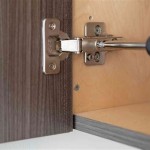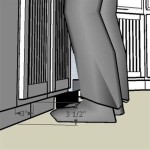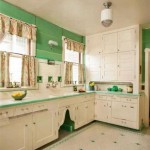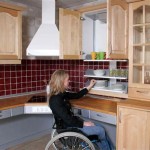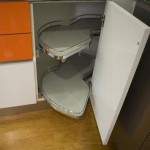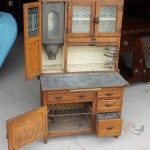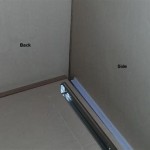Hickory Kitchen Cabinets: Durability, Beauty, and Timeless Appeal
Hickory kitchen cabinets represent a popular choice for homeowners seeking a blend of durability, rustic charm, and natural beauty. This hardwood, known for its strength and distinctive grain patterns, offers a unique aesthetic that can complement a wide range of kitchen styles, from traditional to contemporary. Understanding the properties of hickory, its advantages and disadvantages, and the design considerations involved in incorporating it into a kitchen renovation project is crucial for making an informed decision.
Hickory belongs to the genus *Carya*, which includes various species of nut-bearing trees native to North America. The wood derived from these trees is valued for its hardness, density, and shock resistance. Historically, hickory has been used in applications demanding strength and resilience, such as tool handles, sports equipment, and flooring. Its inherent durability makes it an excellent material for kitchen cabinets, which are subject to daily wear and tear.
The visual appeal of hickory lies in its contrasting grain patterns and color variations. Heartwood, the denser wood from the center of the tree, often exhibits a rich, reddish-brown hue, while sapwood, the outer layer, is typically lighter in color, ranging from creamy white to pale yellow. This natural variation creates a striking and distinctive look that adds character and warmth to a kitchen. The grain patterns can range from straight and consistent to wildly figured, depending on the specific tree and cut of the wood.
When considering hickory kitchen cabinets, it's important to understand the factors that contribute to their overall quality, cost, and suitability for a particular home. This includes understanding the different grades of lumber, construction methods, and finishing options.
Key Point 1: The Advantages of Hickory Kitchen Cabinets
Hickory kitchen cabinets offer several key advantages that make them a desirable choice for many homeowners. These advantages stem from the inherent properties of the wood itself and the design possibilities it offers.
One of the primary benefits of hickory is its exceptional durability. Hickory is one of the hardest domestic hardwoods available, making it highly resistant to dents, scratches, and other forms of damage. This durability translates to cabinets that can withstand the rigors of a busy kitchen environment, maintaining their beauty and functionality for years to come. In kitchens with high foot traffic or frequent use, hickory's resilient nature makes it a practical and long-lasting option. The hardness also allows for intricate detailing and shaping without compromising the integrity of the cabinet doors and frames.
Beyond its strength, hickory boasts a unique and attractive aesthetic. The contrasting color variations and prominent grain patterns create a visually dynamic surface that adds warmth and character to the kitchen. This natural variation means that no two hickory cabinets will be exactly alike, resulting in a truly custom and personalized look. The distinct grain patterns provide visual interest and depth, complementing various design styles. The wood's natural tones can range from light to dark, accommodating different color palettes and design preferences.
Hickory cabinets provide design versatility, lending themselves well to both traditional and modern kitchen designs. In traditional kitchens, hickory cabinets can be paired with raised-panel doors, ornate hardware, and classic countertops to create a warm and inviting atmosphere. In more modern kitchens, hickory cabinets can be used with slab doors, minimalist hardware, and sleek countertops to create a more contemporary and streamlined look. The wood’s natural beauty works well with a variety of finishes, from natural stains that enhance the grain to painted finishes that complement other design elements.
Furthermore, hickory is a sustainable wood source. Hickory trees are abundant in North America and are often harvested responsibly, making them an environmentally conscious choice for homeowners. Choosing hickory can support sustainable forestry practices and reduce the environmental impact compared to using exotic or less sustainably sourced woods. The longevity of hickory cabinets also contributes to sustainability by reducing the need for frequent replacements.
Key Point 2: Potential Drawbacks of Hickory Cabinets
While hickory kitchen cabinets offer numerous advantages, it's important to consider potential drawbacks before making a decision. These drawbacks primarily relate to cost, maintenance, and the inherent characteristics of the wood.
Hickory cabinets can be more expensive than cabinets made from other materials, such as maple or oak. The higher cost reflects the relative scarcity of high-quality hickory lumber, the processing required to prepare it for cabinet construction, and the labor involved in working with such a hard and dense material. This price difference can be a significant factor for homeowners on a budget. The cost can also vary depending on the grade of hickory used, with higher grades commanding a premium price.
Due to its hardness, hickory can be more challenging to work with than other hardwoods. This means that cabinetmakers may need to use specialized tools and techniques, which can add to the overall cost of the project. The density of the wood can also make it more difficult to achieve perfectly smooth finishes, especially when staining. The complex grain patterns require careful sanding and finishing to achieve a consistent and attractive result.
Because of its natural variations in color and grain, achieving a uniform look with hickory cabinets can be difficult. The contrasting heartwood and sapwood can create a patchwork effect if not carefully managed during the design and construction process. While some homeowners appreciate this natural variation, others may prefer a more consistent and uniform appearance. Proper planning and selection of lumber are essential to minimize unwanted variations.
Hickory, like all wood, is susceptible to changes in humidity. Extreme fluctuations in humidity can cause the wood to expand and contract, potentially leading to warping, cracking, or joint separation. Maintaining a stable humidity level in the kitchen is crucial to prevent these issues. This may require the use of a humidifier or dehumidifier, depending on the climate and season.
Darker stains on hickory can sometimes appear blotchy due to the varying densities within the wood. This uneven absorption of stain can result in an inconsistent color, which may be undesirable for some homeowners. Proper preparation and the use of a wood conditioner can help to minimize this issue, but it's important to be aware of the potential for blotchiness when choosing a stain color.
Key Point 3: Design Considerations for Hickory Kitchen Cabinets
Successfully incorporating hickory kitchen cabinets into a design requires careful consideration of several factors, including style, color palette, hardware, and countertop choices. Thoughtful planning can maximize the visual appeal of the wood and create a cohesive and functional kitchen space.
Hickory cabinets can be adapted to a variety of kitchen styles, but they are particularly well-suited to rustic, farmhouse, and transitional designs. In rustic kitchens, hickory can be paired with natural stone, exposed beams, and wrought-iron hardware to create a warm and inviting atmosphere. In farmhouse kitchens, hickory cabinets can be combined with white subway tile, apron-front sinks, and vintage-inspired accessories for a charming and timeless look. In transitional kitchens, hickory can be used with both traditional and modern elements to create a balanced and sophisticated space.
Choosing the right color palette is crucial for complementing the natural tones of hickory. Earthy colors, such as greens, browns, and creams, work well with the warm hues of the wood. Lighter colors, such as whites and grays, can create a more contemporary look while still highlighting the beauty of the grain. Bold colors, such as blues or reds, can be used as accents to add visual interest and contrast. It's important to consider the overall lighting in the kitchen when selecting a color palette, as different colors will appear differently under different lighting conditions. Consider the flooring and wall colors in relation to the hickory cabinetry.
Hardware choices can have a significant impact on the overall look of hickory kitchen cabinets. For a rustic or farmhouse kitchen, consider using antique brass or wrought-iron hardware. For a more modern kitchen, opt for stainless steel or brushed nickel hardware. The style of the hardware should complement the door style and the overall aesthetic of the kitchen. Simple, clean lines work well with slab doors, while more ornate hardware can be used with raised-panel doors. The size and placement of the hardware should also be carefully considered to ensure both functionality and visual appeal.
Countertop materials should be chosen to complement the color and texture of the hickory cabinets. Granite, quartz, and butcher block are all popular choices for pairing with hickory. Granite provides a natural and durable surface with a wide range of colors and patterns to choose from. Quartz is a low-maintenance and non-porous option that offers a consistent and modern look. Butcher block adds warmth and character to the kitchen and is a great choice for creating a farmhouse or rustic feel. The countertop edge profile can also impact the overall look, with options ranging from simple square edges to more decorative ogee edges.
The finish applied to hickory cabinets can significantly alter their appearance. Natural finishes enhance the wood’s grain and color variations, showcasing its inherent beauty. Stained finishes can deepen the color or create a more uniform look. Painted finishes provide a more contemporary look and can be used to complement a variety of color palettes. The choice of finish should be based on the desired aesthetic and the overall design of the kitchen. Consider the sheen level of the finish as well, as higher sheens will reflect more light and lower sheens will create a more muted look.

Amish Rustic Hickory Kitchen Cabinets 10x10 L Shaped Design

Hickory Kitchen Cabinets Rustic Charm Meets Modern

Awesome Kitchen Island Pendant Lights Cabinet Styles Farmhouse Style Cabinets Hickory

Hickory Dewils

Hickory Shaker Kitchen Cabinets A Strong Solution Great Buy

Knotty Hickory Shaker Kitchen Cabinets 10x10 L Shaped Design

Hampton Bay 30 In W X 24 D 34 5 H Assembled Base Kitchen Cabinet Natural Hickory With Drawer Glides Kb30 Nhk The Home Depot

Hickory Cabinets Ideas And Inspiration Hunker

Why We Love Hickory Cabinets

Hickory Shaker Kitchen Cabinets Knotty Rustic Modern Hong Kong
Related Posts

